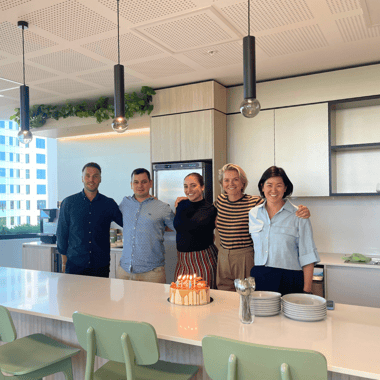
The latest community insights from HR leaders

Structured, well-considered planning, with a structured approach will no doubt be key to the future of work. However, communication and regular engagement with employees will likely be the differentiators that unlock the effectiveness of a remote workforce.
The latest in the Six Degrees community insight sharing sessions connected HR leaders from some of Australia’s key FMCG manufacturing organisations with HR Executives from two blue chip US FMCG organisations. With the state of crisis heightened in the US, they shared their challenges, successes and advice in dealing with COVID -19.
Hot among the topics were managing of workforce interfacing on sites and with clients, managing the wholesale shift for workforces to work from home and the mental health of their teams through such a tumultuous period.
Crisis project teams
Early on, the key to managing effectively was the development of project-based operation teams with so much changing rapidly, more information that is realistically useable, and significant levels of stress within organisations. These teams allowed crisis response to work in a more agile manner rather than getting bogged down navigating through large committees. Teams were able to map exactly their resourcing requirements, deployment and how this can be pivoted or altered as conditions change. Realistically for a lot of businesses, staff reduction was unavoidable; and velocity was the key factor required in the decision-making process, of which these project-based teams were able to provide.
Underperforming or underutilised team members were among the first to be stood down or repurposed; the remaining teams have been able to work effectively with cross-functional up-skilling provided to allow further opportunities to be developed and the capacity of staff maximised during quieter periods. Some arms of businesses have been restructured to better serve the changing client profile (such as on-premise sales’ teams now pivoting to bolster than ranks of the at-capacity grocery & convenience teams).
Redundancies and stand-downs, where clearly communication and transparent, have been received well; with the bulk of work forces understanding that these unprecedented times require significant, but calculated measures. Some great examples were also shared of businesses offering further support where they could to furloughed staff (such as continuing to provide health insurance).
Staff interface and management of symptoms for workforces
Businesses have made decisions early on to target how their sales’ teams were interfacing in person with their clients. The COVID-19 situation has been unique in providing businesses with the catalyst they required to invest more heavily in IT infrastructure & make greater use of video conferencing; and this has flowed through to sales teams in order to maintain the necessary touchpoints with their clients. It has also deepened conversations sales teams are having, particularly with smaller businesses (with one of our HR Executives talking through how their sales team have been able to roll out insight sessions to assist these smaller businesses in the management of their own workforces).
For operational staff in warehouses & DCs the key has been rigorous contact testing. One business has even implemented an HR response team whose’ role is to field a hotline for any staff who think they are exhibiting symptoms of COVID-19. These staff are isolated & tested immediately, as well as having their contact mapped to further staff isolation until testing is returned. From over 500 symptomatic staff, this business has returned only 5 positive tests; and due to the stringent and proactive containment measures have not had a single site offline thus far. This protocol has also extended to their network of delivery drivers; including increased efforts to eliminate interpersonal contact with clients by removing pallet breakdown at delivery, and contactless connote management.
Mental health during isolation
With staff separated and isolated, stressed around the epidemic and economic impact it will have, as well as concerned for family & friends, there is significant strain on the mental wellbeing of workforces globally. Key in HR teams managing this is a high touchpoint, individualised approach; making use of all the modern technology to ensure as much connection is maintained despite physical limitations. In order to ensure workforces are included and up to date; weekly, companywide digital town halls help disseminate information, allow for Q&A sessions and ensure staff are provided with a transparent finger on the pulse of the businesses (critical given a time when things are changing so rapidly).
Additionally, the oversaturation of information can be combatted through this method, allowing for clear and uniform communication from the top down. Individual team leaders, as well as HR personnel and ELT members are checking in on their teams throughout the day to provide support, and then after hours unwinding with team based digital meetups – strengthening the bonds and support networks for employees. EAP programs, wellbeing apps and access to organisations such as HeadSpace, as well as tips for managing isolation can also be shared in weekly newsletters; providing resources to avoid leaving staff feeling stranded and helpless.
What does the future look like? Return to work and the Future of Work
Key across all businesses will be how they move back to full operation as we look to the post COVID-19 future. Uniformly there are conservative estimates around when this may occur (with concern in the US around even a potential second wave of infection that will coincide with the cooler months of the year as per the CDC). Having a roadmap for the gradual ramp up back to business as usual is critical, to ensure organisations emerge from this period effectively, and without placing any undue risk or pressure on workforces. A great example of this style of roadmap is the NSW Back to School report; which has even been adopted to inform businesses in the US as to how they approach this.
Looking forward, it seems that how workforces are dispersed, and function effectively will be forever changed in the post COVID-19 world. With IT infrastructure allowing significant portions of white-collar staff to work effectively from home, companies are now looking at what this means for their bricks and mortar sites. Some have identified downsizing, subletting and even eliminating shared or rented office space in favour of work from home approaches, with significant benefits to operational fixed costs.
Overwhelmingly, the theme of the session was that conservative planning, with a structured approach is key. Safeguarding the flow of clear & targeted comms will ensure effective utilisation of capacity; and keeping in regular contact with staff across all aspects of the business (both 1 on 1 and socially) will unlock the true effectiveness of a remote workforce.
For market insights and to find talent, contact our team of experts.
Related


Developing a Career Plan
Just as any successful organisation meticulously crafts a clear and strategic business plan to...

What to expect when meeting a recruiter for an interview
Meeting with a recruitment consultant is an opportunity to demonstrate how you will present for a...


 Accessibility
Accessibility